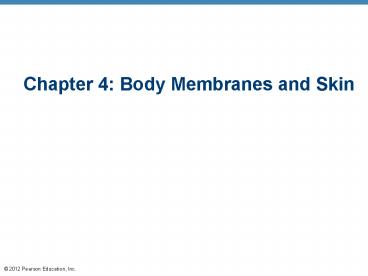Chapter 4: Body Membranes and Skin - PowerPoint PPT Presentation
1 / 13
Title:
Chapter 4: Body Membranes and Skin
Description:
Chapter 4: Body Membranes and Skin Body Membranes Function of body membranes Cover body surfaces Line body cavities Form protective sheets around organs Classified ... – PowerPoint PPT presentation
Number of Views:213
Avg rating:3.0/5.0
Title: Chapter 4: Body Membranes and Skin
1
Chapter 4 Body Membranes and Skin
2
Body Membranes
- Function of body membranes
- Cover body surfaces
- Line body cavities
- Form protective sheets around organs
- Classified according to tissue types
3
Classification of Body Membranes
- A. Epithelial membranes
- Cutaneous membranes
- Mucous membranes
- Serous membranes
- B. Connective tissue membranes
- Synovial membranes
4
A. Epithelial Membranes
- 1. Cutaneous membrane skin or integument
- Dry membrane
- Outermost protective boundary
- Superficial epidermis is composed of keratinized
stratified squamous epithelium - Underlying dermis is mostly dense connective
tissue
5
Cutaneous membrane (skin)
- Cutaneous membrane (the skin)
- covers the body surface.
Figure 4.1a
6
2. Mucous Membranes
- Surface epithelium type depends on site
- Stratified squamous epithelium (mouth, esophagus)
- Simple columnar epithelium (rest of digestive
tract) - Underlying loose connective tissue (lamina
propria) - Lines all body cavities that open to the exterior
body surface - Often adapted for absorption or secretion
7
Mucosa of nasal cavity
Mucosa of mouth
Esophagus lining
Mucosa of lung bronchi
(b) Mucous membranes line body cavities
open to the exterior.
Figure 4.1b
8
3. Serous Membranes
- Surface is a layer of simple squamous epithelium
- Underlying layer is a thin layer of areolar
connective tissue - Lines open body cavities that are closed to the
exterior of the body - Serous membranes occur in pairs separated by
serous fluid - Visceral layer covers the outside of the organ
- Parietal layer lines a portion of the wall of
ventral body cavity
9
Outer balloon wall (comparable to parietal serosa)
Air (comparable to serous cavity)
Inner balloon wall (comparable to visceral serosa)
(d) A fist thrust into a flaccid balloon
demonstrates the relationship between the
parietal and visceral serous membrane layers.
Figure 4.1d
10
Serous Membranes
- Specific serous membranes
- Peritoneum
- Abdominal cavity
- Pleura
- Around the lungs
- Pericardium
- Around the heart
11
Parietal pleura
Parietal peritoneum
Visceral pleura
Visceral peritoneum
Parietal pericardium
Visceral pericardium
(c) Serous membranes line body cavities
closed to the exterior.
Figure 4.1c
12
B.Connective Tissue Membrane
- 1. Synovial membrane
- Connective tissue only
- Lines fibrous capsules surrounding joints
- Secretes a lubricating fluid synovial fluid
13
Ligament
Joint cavity (contains synovial fluid)
Articular (hyaline) cartilage
Fibrous capsule
Articular capsule
Synovial membrane
Figure 4.2































